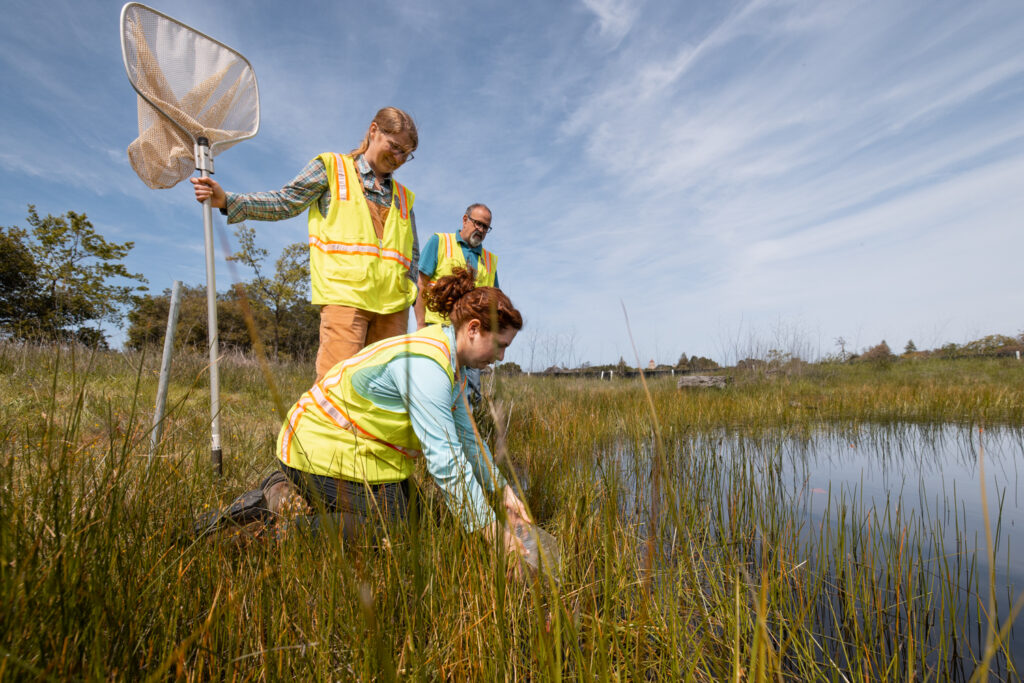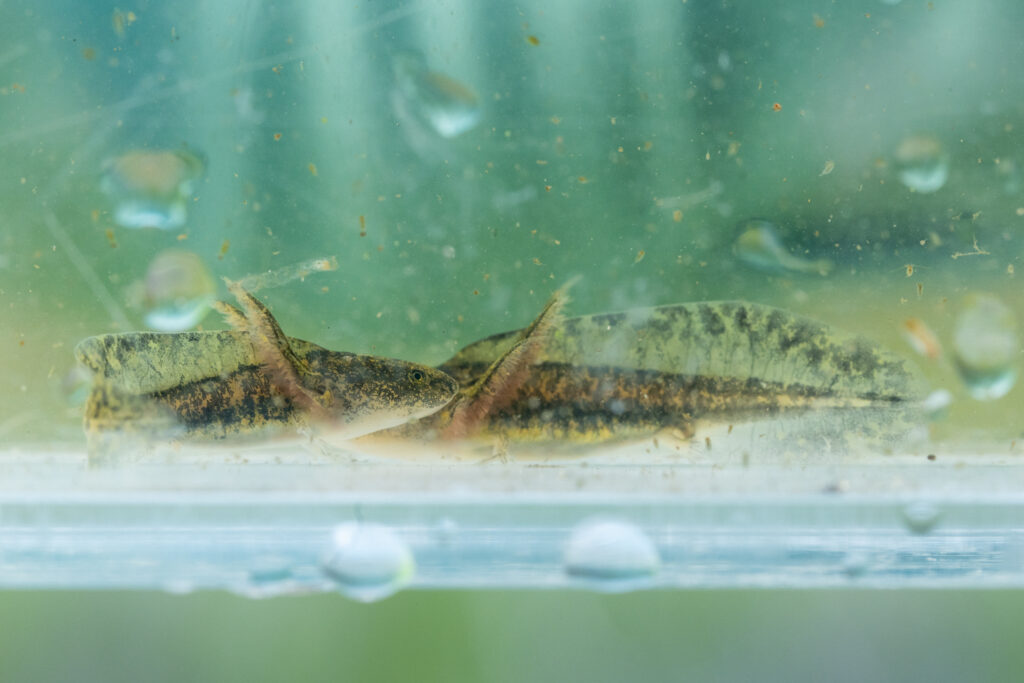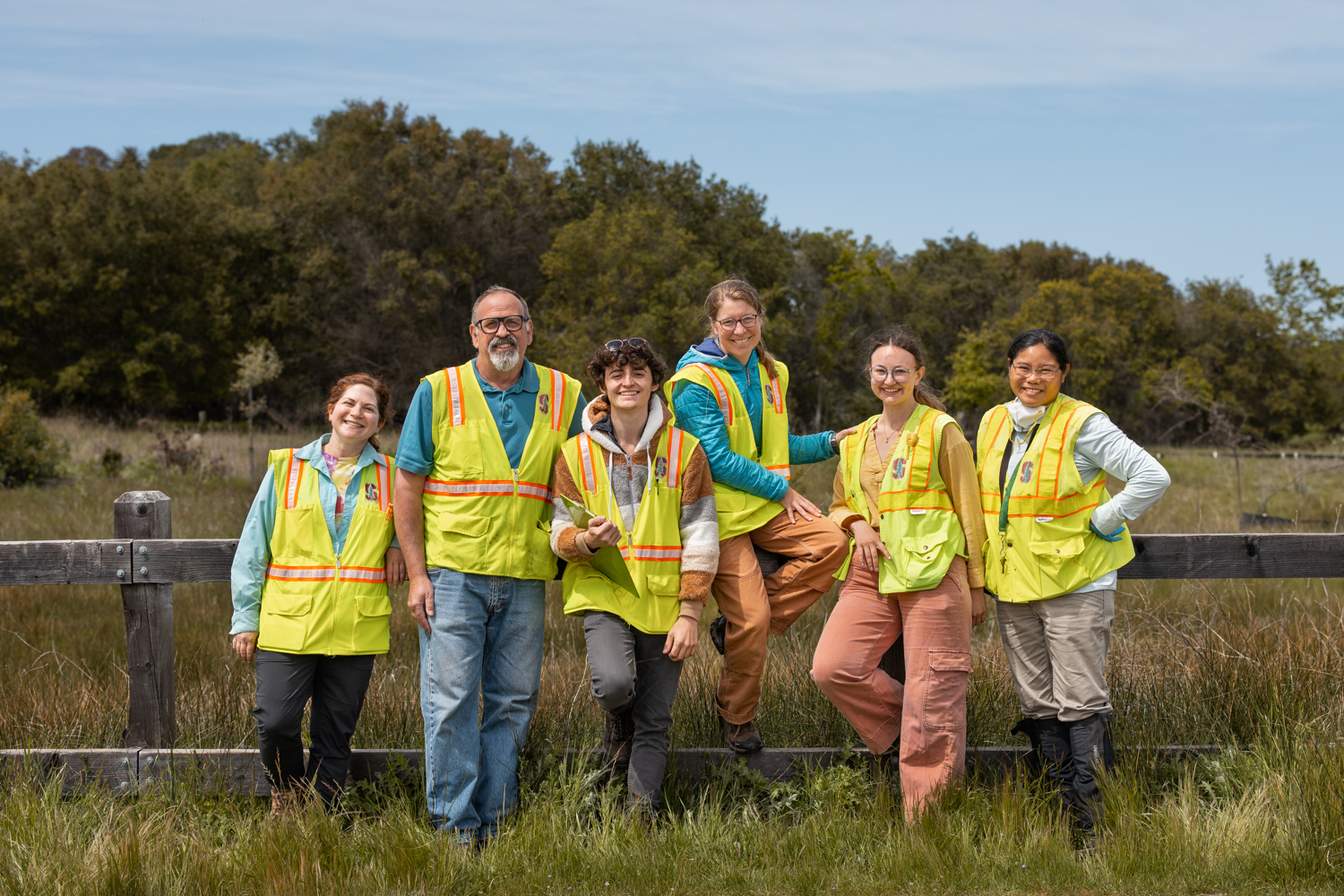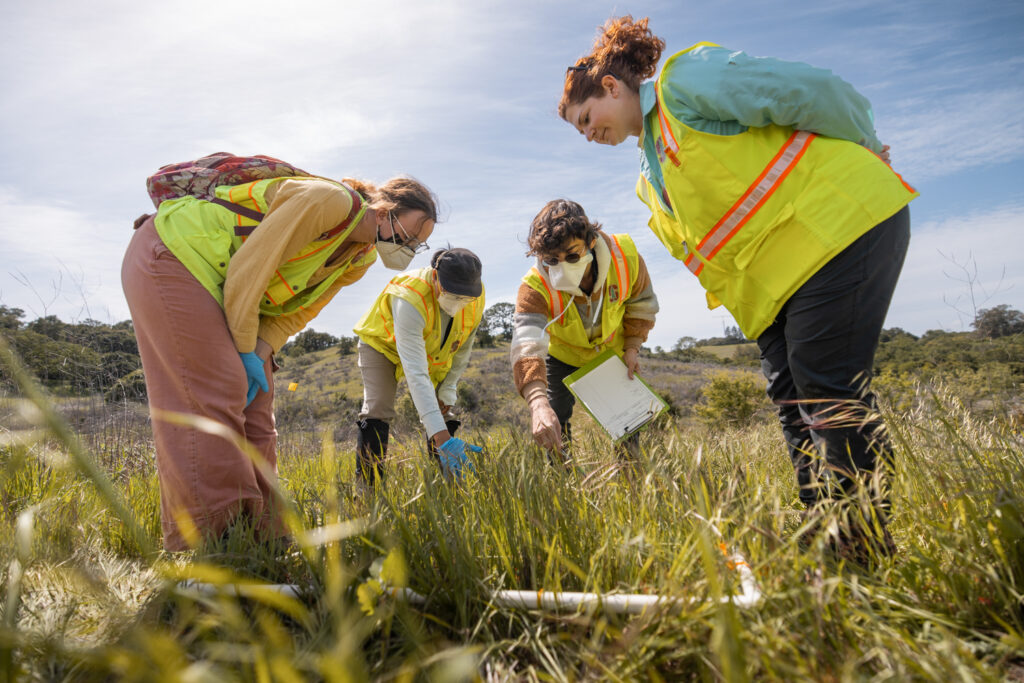Meet the team preserving Stanford’s land, water, and wildlife
The staff behind the Conservation Program are leading Stanford’s land stewardship efforts to ensure the university’s vast natural landscape and biodiversity can thrive.
On a recent afternoon in the Stanford foothills, a few hundred meters from the Dish, a crew of Stanford conservationists inspected a pond where California tiger salamanders are successfully breeding.

Katie Preston, Esther Adelsheim, and Alan Launer inspect a pond in the Stanford foothills where California tiger salamanders are breeding. (Image credit: Andrew Brodhead)
“The recent rain has been really positive for these salamanders because it fills up their breeding ponds,” said Esther Adelsheim, program manager in Stanford’s Conservation Program.
Due, in part, to years of drought and habitat conversion, the slithery black and yellow amphibian is a state and federally-recognized threatened species. But constructed pools like this – one of eight at Stanford – are increasing their chances of survival. With around 800 eggs in that pond alone, Adelsheim is optimistic about the species’ future.
“The more aquatic habitat they have, the more successful they’ll be in contributing juvenile salamanders that will sustain and bolster the population into the future,” she said.
Maintaining habitats is just one small part of the work Stanford’s Conservation Program is doing to steward university lands. The team is also supporting biological research, providing educational opportunities for students and the broader community, inspiring local stewardship, and helping fulfill Stanford’s commitment to protecting and bolstering local biodiversity.
Conservation at Stanford
Stanford’s natural landscape has long been a mainstay of the campus and unique among colleges and universities due to its size. In 1876, Leland and Jane Stanford purchased 650 acres of land where they built their country home, Palo Alto Stock Farm, and later their university. Leland Stanford later acquired the adjoining properties, growing the campus to more than 8,000 acres, much of which remains undeveloped.

California tiger salamanders are successfully breeding and producing juveniles in ponds in the Stanford foothills. (Image credit: Andrew Brodhead)
Alan Launer, director of conservation planning, said that the university has done some form of conservation work for decades, much of which was driven by faculty research. In the 1980s and 1990s, he was working with the Center for Conservation Biology, the research group started by Paul Ehrlich, the Bing Professor of Population Studies, Emeritus.
“We did very applied conservation all across the United States and internationally, including Costa Rica and Madagascar,” Launer said.
Around that time, the group began working with the university on issues related to land use, water storage, and preserving endangered species. As state and federal endangered species lists grew, so did the partnership between Ehrlich’s group and the university, with part of the Center moving to the university administration in the late 1990s.
Today the Conservation Program is part of Land, Buildings, and Real Estate (LBRE) and run by three permanent, full-time staff: Launer, Adelsheim, and Katie Preston, the conservation program coordinator. With help from various seasonal staff, including Stanford students, they protect the biodiversity of Stanford lands, water, and wildlife.
Land, water & wildlife
On any given day, the team can be found conducting vegetation management for the 670 species of native plants and over 325 species of non-native plants on Stanford’s campus. That work includes restoring native trees and plants, seeding grassland species and milkweed, advising on grazing management, or conducting weed control and biological monitoring of terrestrial species. They are also heavily involved with Stanford’s water management systems, including Lagunita, Felt Reservoir, and Searsville Reservoir.
Much of their work focuses on supporting the various animal species at Stanford. There are about 150 species of birds, over 45 species of mammals, 19 species of reptiles, 11 species of amphibians, eight species of fish, and countless species of invertebrates. Many of these animals are at risk of extinction.
“I get the greatest joy and satisfaction from our efforts to preserve and support biodiversity as a whole in both aquatic and terrestrial environments,” Adelsheim said. “When a pond is full of native invertebrates, plants, amphibians, reptiles, and birds, it’s a joy to witness.”
But maintaining a healthy ecosystem for this wildlife to thrive isn’t easy. The team faces numerous obstacles, most notably from the impacts of climate change, which Adelsheim described as, “hands-down our biggest challenge.” She explained that in some years, California’s historic drought has left them without enough water.
“As a result, we’ve been dealing with drying ponds and shortened hydroperiods, which reduces survival to metamorphosis for pond breeding amphibians,” she said, adding that years with heavy rainfall have led to water storage and management problems.
The large human population surrounding Stanford can also adversely impact the campus ecology. Years of local development have led to increased foot and vehicle traffic, littering, and other human activity that can harm the local environment.
Education and research
One of the best ways to reduce the adverse impacts of human activity is through outreach. The Conservation Program supports numerous educational programs, including the Jasper Ridge Biological Preserve Docent Program, Stanford Bioblitz, the California Naturalists Program, and Biocure Explorations. It also organizes field trips for students at local schools, volunteer opportunities, and public webinars and presentations on topics like the connection between social and environmental systems and the importance of native plant restoration.
“Our program is also very supportive of students,” Preston said. “We hire seasonal technicians, some of whom are Stanford students, and we sponsor master’s capstone projects and other research, including by scholars at other institutions.”
Stanford courses offered through the Conservation Program include BIO/EARTHSYS 105 – Ecology and Natural History of Jasper Ridge, BIO 810 – Introduction to Ecology, and BIO 159 – Herpetology, co-taught by Adelsheim.
Partnerships
Launer, Adelsheim, and Preston said that while their team is small relative to the scope of their work and the vastness of Stanford’s land, their efforts go a long way, thanks in part to the partnerships they’ve built.
“It is important to acknowledge the community of volunteers and collaborators upon which we rely,” said Adelsheim. “Sometimes, the work that we do requires a large number of helping hands – whether that is people that come out to weed or plant during volunteer work days or people that have the curiosity to learn about local biodiversity and advocate for its conservation.”

